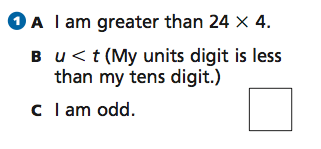Puzzles: Who Am I Puzzles
Who-Am-I? puzzles give clues about some mathematical object — usually a number or a shape — and you are to figure out what the object is. Think Math! introduces Who-Am-I? puzzles in grade 3, chapter 4, in the service of place value, where the puzzles are called Mystery Number Puzzles.
Purpose
These puzzles develop academic language and specific vocabulary connected with discussion of place value, and provides practice with place value ideas.
Examples
Here is one puzzle about a two digit number, from Think Math!, grade 3 (LAB book, page 73):
 .
.
These Who-Am-I? puzzles were invented by a second grader, Lena.
Who am I?
- I am a 2-digit number.
- I am an even number.
- The sum of all my digits together is 3.
- The order of my digits goes smallest to greatest.
Who am I?
- I am a 3-digit number.
- I am odd.
- The sum of my digits together is 15.
- All of my digits are odd.
- The order of my digits goes smallest to greatest. (left to right)
- I am a multiple of 7.
Who am I?
- I am a 4-digit number.
- In my number there are only two different digits.
- The sum of all my digits is 6.
- My hundreds digit is less than 2.
- My tens digit is even.
- The order of my digits is least to greatest.
When you make up puzzles of this kind, it is often good to give “wasted clues” — clues that aren’t needed. For example, if one clue is “my units digit is even” and another clue is “I’m an even number,” one of those clues is not needed. When teaching with the puzzles, it is good to ask students if they really need all of the clues. This helps them focus on how much information they get from each clue. Did Lena give any clues that were not needed?
